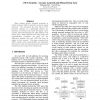Free Online Productivity Tools
i2Speak
i2Symbol
i2OCR
iTex2Img
iWeb2Print
iWeb2Shot
i2Type
iPdf2Split
iPdf2Merge
i2Bopomofo
i2Arabic
i2Style
i2Image
i2PDF
iLatex2Rtf
Sci2ools
ACSAC
2004
IEEE
2004
IEEE
.NET Security: Lessons Learned and Missed from Java
Many systems execute untrusted programs in virtual machines (VMs) to limit their access to system resources. Sun introduced the Java VM in 1995, primarily intended as a lightweight platform for execution of untrusted code inside web pages. More recently, Microsoft developed the .NET platform with similar goals. Both platforms share many design and implementation properties, but there are key differences between Java and .NET that have an impact on their security. This paper examines how .NET's design avoids vulnerabilities and limitations discovered in Java and discusses lessons learned (and missed) from Java's experience with security.
| Added | 20 Aug 2010 |
| Updated | 20 Aug 2010 |
| Type | Conference |
| Year | 2004 |
| Where | ACSAC |
| Authors | Nathanael Paul, David Evans |
Comments (0)

